
Revolutionary composer, gambist, and singer Claudio [Giovanni Antonio] Monteverdi (May 15, 1567 [baptism], Cremona, Italy - November 29,1643) marks the transition from Renaissance to Baroque music, and during his long life he produced works on the cusp.
He studied with Marc'Antonio Ingegneri, the singing master of Cremona cathedral, producing his first music for publication -- motets and sacred madrigals -- in 1582 and 1583, and his opening gambit of the secular variety of the latter in 1587, shortly thereafter looking for work outside his native city.
In 1590, Monteverdi began working at the court of Vincenzo I of Gonzaga in Mantua as a vocalist and viol player, and in this period (1597) comes the earliest known image of the composer, at about age 30, where, by 1602 he had become the court conductor.
He worked primarily on madrigals until age 40, composing nine books.
The Quinto Libro (Fifth Book) (1605) was at the heart of the controversy with Giovanni Artusi, who attacked the "crudities" and "license" of such works as, appropriately, Cruda Amarilli.
Monteverdi's reply in his above book proposed the division of musical practice into two streams:
Prima Pratica -- the polyphonic late Renaissance style of flowing strict counterpoint, prepared dissonance, and equality of voices -- and
Seconda Pratica -- the freer counterpoint of an increased hierarchy of voices, emphasizing soprano and bass, moving towards monody, with the introduction of continuo and functional harmony.
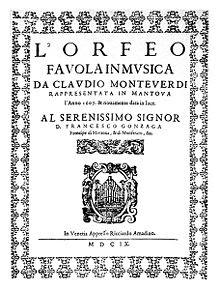 Monody -- with its emphasis on recitatives and melodies, featuring intelligible text and placid accompanying music -- set the stage for Monteverdi to participate, albeit belatedly, in the birth of opera with the premiere of L'Orfeo (1607) in his adopted home, the work serving as part of the ducal carnival celebrations
Monody -- with its emphasis on recitatives and melodies, featuring intelligible text and placid accompanying music -- set the stage for Monteverdi to participate, albeit belatedly, in the birth of opera with the premiere of L'Orfeo (1607) in his adopted home, the work serving as part of the ducal carnival celebrations as can be clearly imagined in the opening Toccata, no matter what performance.
as can be clearly imagined in the opening Toccata, no matter what performance.David Munrow (1975)
John Elliot Gardiner (1987)
Philip Pickett (1992)
Jordi Savall (2008)
The opera, on the same subject as both Peri and Caccini's Eurydices, has expressivity, power, and specific orchestration (perhaps the first, or at least one of the first to survive), as an early example of Baroque (from an Italian term for a distorted pearl -- barocco!) opera.
The Prologue: "Dal mio permesso" from the narrator shows the latter style, with nascent use of ritornello forms,
By contrast, the choruses such as Act I: Balletto: "Lasciate i monti" (Chorus Nymphs Shepherds), reflect earlier practices.
[The chorus begins at c. 3:15 -- with questionable changes of tempo]
The dramatic thrust of the work is well encapsulaed by the Act II - Recitatives: "Ahi, caso acerbo (Messenger, Shepherds, Orpheus) and "Tu se' morta" (Orpheus), with its opening underlying harmony of G: i V ii VI i bVII realized from figured bass in free meter, and an initial melodic line of Me Ti (diminished 4th!) Do Do (N.B. The sheet music below is a transcription, and does not reflect Monteverdi's metrics, which actually begin with a double-long whole note).
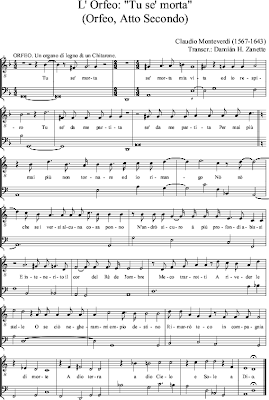
After an initial G Dorian, the recitative slips into D Dorian at the key change. Note the wonderful use of chromatics, the parallel chromatic minor third slide of melodic G# - G against bass B - Bb, and the minor dominant - minor tonic cadence at the conclusion.
All this is is nicely contrasted with the ensuing choral "Ahi, caso acertbo" (Nymphs and Shepherds).
The work was printed two years later, and, the following year, the Vespro della Beata Vergine 1610 (The Vespers of the Blessed Virgin) proved to be on a vast scale of 25 sections. While there have been questions re its composer's performance intentions, there is little doubt of the composition's overall integrity and unity.
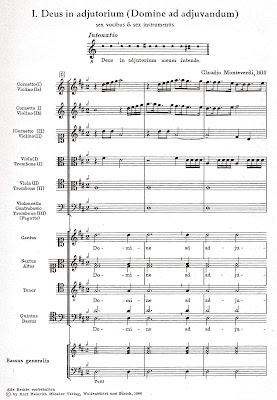
The Vespers begin in Introductio: Domine ad adiuvandum me festina / Deus in adiutorium as an imaginative self-borrowing of the opening Orfeo Toccata, now harmonized by the chorus as a D Major chant against all the contrapuntal punting of same, contrasted with instrumental "renaissancey" ritournelli.
After the alternations of Psalm texts with motets, the XI. Sonata Sopra Sancta Maria is a wild slice-and-dice of chant, against perky instrumental lines of cornetts et al.
And following a lengthy series of selections, the late-arriving XIII. Magnificat still packs a magnificent emotional wallop.
Monteverdi became conductor at Venice's San Marco in 1613, and finished there his sixth, seventh and eighth books of madrigals.
It was during these years that his most renowned student, Heinrich Schütz (1585-1672), made his second trip to Venice (1628), and took the new baroque style back with him to Germany. Monteverdi was ordained a Catholic priest four years later, in 1632.
His Ottavo Libro (1638), the composer's largest book of madrigals as a compendium of works over 33 years, includes the Madrigali dei guerrieri ed amorosi, a perfection of madrigal form, and the dramatic scene composed years earlier as Tancredi e Clorinda (1624), where orchestra and voices form separate entities.
Much of this harkens back to the Gabrielis enthusiasms for spatial music the Venice of the late renaissance. Tancredi also features the first-time use of tremolo and pizzicato.
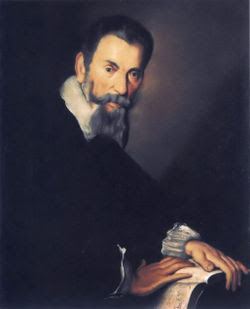
During the last years of his life, Monteverdi was often ill, though this is less obvious in upper, rather than lower portrait, both dating from 1640,
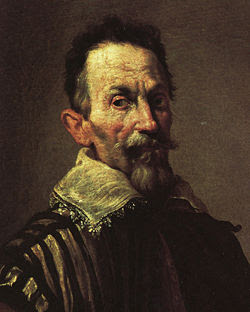
when soon thereafter he completed two late operatic masterpieces:

Il Ritorno d'Ulisse in Patria (The Return of Ulysses to his Homeland, 1641), and the L'Incoronazione di Poppea (The Coronation of Poppea, 1642). The latter, based on the life of Nero, contains tragic, romantic, as well as comic scenes (a first?). Poppea requires a smaller orchestra, and has a less prominent role for the choir. Both works were written for the first opera houses supported by ticket sales.
In total Monteverdi composed at least 18 operas, but, aside from the above three, only the "Lamento" from his second opera l'Arianna survives.
And, of course, he didn't either, dying in his second adopted home, Venice, and buried in the church of the Frari.
A ninth book of madrigals, published posthumously in 1651, contains lighter pieces such as canzonettas, and is again a prescis of older works representing prima and seconda praticca.

We bid adieu with a posthumous portrait medallion, etched by Barberis.
 Scales in E; C Minor, A Major
Scales in E; C Minor, A Major
Related Reading:
Pierro Weiss and Richard Taruskin
Music in the Western World: A History in Documents
L'Orfeo: Prologue (Alessandro Striggio) (1607) (Pages 177-178)
Scherzi Musicali: Declaration (1607) (Pages 172-173)
Two Letters to Alessandro Striggio (1616, 1620) (Pages 180-184)
Madrigali Guerrieri e Amarosi: Preface (1638) (Pages 173-174)
***

[Farinelli (1705-1762)]
Castrati had parts in the earliest operas: in the first performance of Monteverdi's Orfeo (1607) they played subsidiary roles, including that of Euridice. By 1680, however, they had supplanted "normal" male voices in lead roles, and retained their hegemony as primo uomo for about a hundred years; an opera not featuring at least one renowned castrato in a lead part would be doomed to fail. Because of the popularity of Italian opera throughout 18th-century Europe (except France), singers such as Ferri, Farinelli, Senesino and Pacchierotti became the first operatic superstars, earning enormous fees and hysterical public adulation. The strictly hierarchical organisation of opera seria favoured their high voices as symbols of heroic virtue, though they were frequently mocked for their strange appearance and bad acting.
The strongest objection against castrati in Europe of the last few centuries was based on the means by which the preparation of future singers frequently led to their premature deaths. To prevent the child from experiencing the intense pain of castration, many were inadvertently administered lethal doses of opium or something similar.
The music historian Charles Burney was sent fruitlessly in search of places where the operation was carried out: "I enquired throughout Italy at what place boys were chiefly qualified for singing by castration, but could get no certain intelligence. I was told at Milan that it was at Venice; at Venice that it was at Bologna; but at Bologna the fact was denied, and I was referred to Florence; from Florence to Rome, and from Rome I was sent to Naples... it is said that there are shops in Naples with this inscription: 'QUI SI CASTRANO RAGAZZI' ("Here boys are castrated"); but I was utterly unable to see or hear of any such shops during my residence in that city."
The training of the boys was rigorous. The regime of one singing school in Rome (c. 1700) consisted of one hour of singing difficult and awkward pieces, one hour practising trills, one hour practising ornamented passaggi, one hour of singing exercises in their teacher's presence and in front of a mirror so as to avoid unnecessary movement of the body or facial grimaces, and one hour of literary study; all this, moreover, before lunch. After, half-an-hour would be devoted to musical theory, another to writing counterpoint, an hour copying down the same from dictation, and another hour of literary study. During the remainder of the day, the young castrati had to find time to practice their harpsichord playing, and to compose vocal music, either sacred or secular depending on their inclination.
This demanding schedule meant that, if sufficiently talented, they were able to make a debut in their mid-teens with a perfect technique and a voice of a flexibility and power no woman or ordinary male singer could match.
In the 1720's and 1730's, at the height of the craze for these artificially-preserved voices, it has been estimated that upwards of 4000 boys were castrated annually in the service of art.
Many came from poor homes, and were more or less sold by their parents to the church or to a singing-master, in the hope that their child might be successful and lift them from their lowly status in society (this was the case with Senesino). There are, though, records of some young boys asking to be operated on to preserve their voices (e.g. Caffarelli, who was from a wealthy family: his grandmother gave him the income from two vineyards to pay for his studies).
Caffarelli was also typical of many castrati in being famous for tantrums on and off-stage, and for amorous adventures with noble ladies. Some, as described by Casanova, preferred gentlemen (noble or otherwise).
Modern endocrinology would suggest that the castrati's much-vaunted sexual prowess was more the stuff of legend than reality. Not all castrated boys had successful careers on the operatic stage; the better "also-rans" sang in cathedral or church choirs, while some, trained as they were in acting, may have turned to the theatre, or perhaps even prostitution.
***

Adriano Banchieri (September 3, 1568, Bologna - 1634, Bologna) was an Italian composer, music theorist, organist and poet of the late Renaissance and early Baroque eras. He founded the Accademia dei Floridi in Bologna.
In 1587, he became a monk of the Benedictine order, taking his vows in 1590, and changing his name to Adriano (from Tommaso). One of his teachers at the monastery was Gioseffo Guami, who had a strong influence on his style.
Like Orazio Vecchi he was interested in converting the madrigal to dramatic purposes.
Specifically, he was one of the developers of a form called "madrigal comedy" -- unstaged but dramatic collections of madrigals which, when sung consecutively, told a story.
He wrote five such between 1598 and 1628 with "plot and character development," from La pazzia senile to La saviezza giovenile.
Additionally, he was an important composer of canzonettas, a lighter and hugely popular alternative to the madrigal in the late 16th Century. Banchieri disapproved of the monodists with all their revolutionary harmonic tendencies, about which he expressed himself vigorously in his Moderna Practica Musicale (1613), while systematizing the legitimate use of the monodic art of figured bass.
In several editions beginning in 1605 (reprinted at least six times before 1638), Banchieri published a series of organ works entitled l'Organo suonarino.
His last publication was the Trattenimenti da villa (1630).
Further Reading:
Piero Weiss and Richard Taruskin
Music in the Western World: A History in Documents
Adriano Banchieri
Conclusio nel suono del l'organo (Page 179)
[8570 Farmer / 8567 Monteverdi / 8566 Gesualdo]

After an initial G Dorian, the recitative slips into D Dorian at the key change. Note the wonderful use of chromatics, the parallel chromatic minor third slide of melodic G# - G against bass B - Bb, and the minor dominant - minor tonic cadence at the conclusion.
All this is is nicely contrasted with the ensuing choral "Ahi, caso acertbo" (Nymphs and Shepherds).
The work was printed two years later, and, the following year, the Vespro della Beata Vergine 1610 (The Vespers of the Blessed Virgin) proved to be on a vast scale of 25 sections. While there have been questions re its composer's performance intentions, there is little doubt of the composition's overall integrity and unity.

The Vespers begin in Introductio: Domine ad adiuvandum me festina / Deus in adiutorium as an imaginative self-borrowing of the opening Orfeo Toccata, now harmonized by the chorus as a D Major chant against all the contrapuntal punting of same, contrasted with instrumental "renaissancey" ritournelli.
After the alternations of Psalm texts with motets, the XI. Sonata Sopra Sancta Maria is a wild slice-and-dice of chant, against perky instrumental lines of cornetts et al.
And following a lengthy series of selections, the late-arriving XIII. Magnificat still packs a magnificent emotional wallop.
Monteverdi became conductor at Venice's San Marco in 1613, and finished there his sixth, seventh and eighth books of madrigals.
It was during these years that his most renowned student, Heinrich Schütz (1585-1672), made his second trip to Venice (1628), and took the new baroque style back with him to Germany. Monteverdi was ordained a Catholic priest four years later, in 1632.
His Ottavo Libro (1638), the composer's largest book of madrigals as a compendium of works over 33 years, includes the Madrigali dei guerrieri ed amorosi, a perfection of madrigal form, and the dramatic scene composed years earlier as Tancredi e Clorinda (1624), where orchestra and voices form separate entities.
Much of this harkens back to the Gabrielis enthusiasms for spatial music the Venice of the late renaissance. Tancredi also features the first-time use of tremolo and pizzicato.

During the last years of his life, Monteverdi was often ill, though this is less obvious in upper, rather than lower portrait, both dating from 1640,

when soon thereafter he completed two late operatic masterpieces:

Il Ritorno d'Ulisse in Patria (The Return of Ulysses to his Homeland, 1641), and the L'Incoronazione di Poppea (The Coronation of Poppea, 1642). The latter, based on the life of Nero, contains tragic, romantic, as well as comic scenes (a first?). Poppea requires a smaller orchestra, and has a less prominent role for the choir. Both works were written for the first opera houses supported by ticket sales.
In total Monteverdi composed at least 18 operas, but, aside from the above three, only the "Lamento" from his second opera l'Arianna survives.
And, of course, he didn't either, dying in his second adopted home, Venice, and buried in the church of the Frari.
A ninth book of madrigals, published posthumously in 1651, contains lighter pieces such as canzonettas, and is again a prescis of older works representing prima and seconda praticca.

We bid adieu with a posthumous portrait medallion, etched by Barberis.
 Scales in E; C Minor, A Major
Scales in E; C Minor, A MajorRelated Reading:
Pierro Weiss and Richard Taruskin
Music in the Western World: A History in Documents
L'Orfeo: Prologue (Alessandro Striggio) (1607) (Pages 177-178)
Scherzi Musicali: Declaration (1607) (Pages 172-173)
Two Letters to Alessandro Striggio (1616, 1620) (Pages 180-184)
Madrigali Guerrieri e Amarosi: Preface (1638) (Pages 173-174)
***

[Farinelli (1705-1762)]
Castrati had parts in the earliest operas: in the first performance of Monteverdi's Orfeo (1607) they played subsidiary roles, including that of Euridice. By 1680, however, they had supplanted "normal" male voices in lead roles, and retained their hegemony as primo uomo for about a hundred years; an opera not featuring at least one renowned castrato in a lead part would be doomed to fail. Because of the popularity of Italian opera throughout 18th-century Europe (except France), singers such as Ferri, Farinelli, Senesino and Pacchierotti became the first operatic superstars, earning enormous fees and hysterical public adulation. The strictly hierarchical organisation of opera seria favoured their high voices as symbols of heroic virtue, though they were frequently mocked for their strange appearance and bad acting.
The strongest objection against castrati in Europe of the last few centuries was based on the means by which the preparation of future singers frequently led to their premature deaths. To prevent the child from experiencing the intense pain of castration, many were inadvertently administered lethal doses of opium or something similar.
The music historian Charles Burney was sent fruitlessly in search of places where the operation was carried out: "I enquired throughout Italy at what place boys were chiefly qualified for singing by castration, but could get no certain intelligence. I was told at Milan that it was at Venice; at Venice that it was at Bologna; but at Bologna the fact was denied, and I was referred to Florence; from Florence to Rome, and from Rome I was sent to Naples... it is said that there are shops in Naples with this inscription: 'QUI SI CASTRANO RAGAZZI' ("Here boys are castrated"); but I was utterly unable to see or hear of any such shops during my residence in that city."
The training of the boys was rigorous. The regime of one singing school in Rome (c. 1700) consisted of one hour of singing difficult and awkward pieces, one hour practising trills, one hour practising ornamented passaggi, one hour of singing exercises in their teacher's presence and in front of a mirror so as to avoid unnecessary movement of the body or facial grimaces, and one hour of literary study; all this, moreover, before lunch. After, half-an-hour would be devoted to musical theory, another to writing counterpoint, an hour copying down the same from dictation, and another hour of literary study. During the remainder of the day, the young castrati had to find time to practice their harpsichord playing, and to compose vocal music, either sacred or secular depending on their inclination.
This demanding schedule meant that, if sufficiently talented, they were able to make a debut in their mid-teens with a perfect technique and a voice of a flexibility and power no woman or ordinary male singer could match.
In the 1720's and 1730's, at the height of the craze for these artificially-preserved voices, it has been estimated that upwards of 4000 boys were castrated annually in the service of art.
Many came from poor homes, and were more or less sold by their parents to the church or to a singing-master, in the hope that their child might be successful and lift them from their lowly status in society (this was the case with Senesino). There are, though, records of some young boys asking to be operated on to preserve their voices (e.g. Caffarelli, who was from a wealthy family: his grandmother gave him the income from two vineyards to pay for his studies).
Caffarelli was also typical of many castrati in being famous for tantrums on and off-stage, and for amorous adventures with noble ladies. Some, as described by Casanova, preferred gentlemen (noble or otherwise).
Modern endocrinology would suggest that the castrati's much-vaunted sexual prowess was more the stuff of legend than reality. Not all castrated boys had successful careers on the operatic stage; the better "also-rans" sang in cathedral or church choirs, while some, trained as they were in acting, may have turned to the theatre, or perhaps even prostitution.
***

Adriano Banchieri (September 3, 1568, Bologna - 1634, Bologna) was an Italian composer, music theorist, organist and poet of the late Renaissance and early Baroque eras. He founded the Accademia dei Floridi in Bologna.
In 1587, he became a monk of the Benedictine order, taking his vows in 1590, and changing his name to Adriano (from Tommaso). One of his teachers at the monastery was Gioseffo Guami, who had a strong influence on his style.
Like Orazio Vecchi he was interested in converting the madrigal to dramatic purposes.
Specifically, he was one of the developers of a form called "madrigal comedy" -- unstaged but dramatic collections of madrigals which, when sung consecutively, told a story.
He wrote five such between 1598 and 1628 with "plot and character development," from La pazzia senile to La saviezza giovenile.
Additionally, he was an important composer of canzonettas, a lighter and hugely popular alternative to the madrigal in the late 16th Century. Banchieri disapproved of the monodists with all their revolutionary harmonic tendencies, about which he expressed himself vigorously in his Moderna Practica Musicale (1613), while systematizing the legitimate use of the monodic art of figured bass.
In several editions beginning in 1605 (reprinted at least six times before 1638), Banchieri published a series of organ works entitled l'Organo suonarino.
His last publication was the Trattenimenti da villa (1630).
Further Reading:
Piero Weiss and Richard Taruskin
Music in the Western World: A History in Documents
Adriano Banchieri
Conclusio nel suono del l'organo (Page 179)
[8570 Farmer / 8567 Monteverdi / 8566 Gesualdo]
